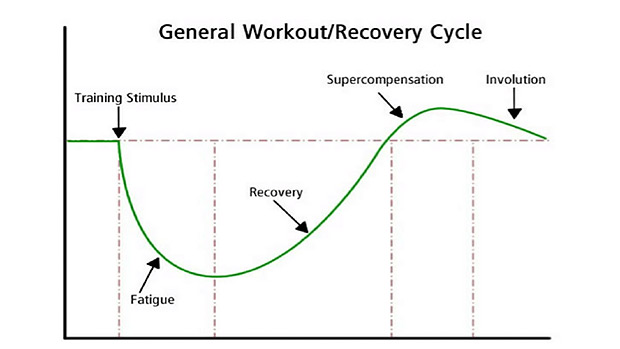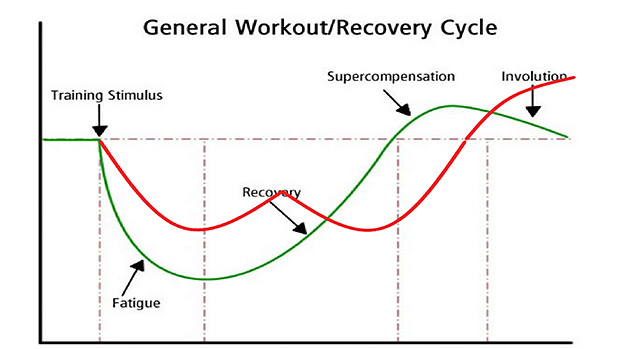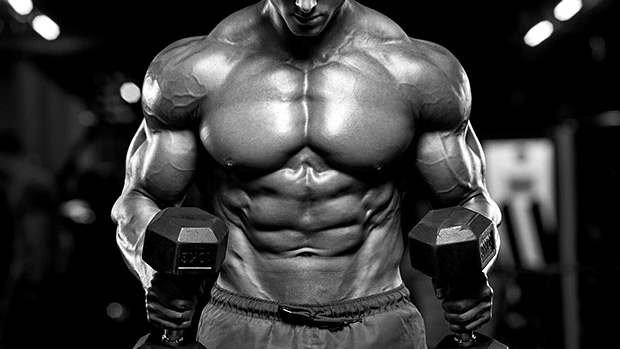Double the Gains?
Twice the workouts mean twice the gains, right? Well, not quite. But you can definitely accelerate muscular gains with smart twice-per-day training.
If you have the time, twice daily training can help "spike" anabolism more frequently while managing the stress response better from what would otherwise be an excessive amount of training. Two-a-days can give you the edge without pushing you over it. Here's how.
You first need to understand how stress works. You're looking for the optimal balance between "good stress" and recovery.
Less is sometimes more. Twice daily training isn't about doing double the work volume. With each workout, the goal is to stimulate, not annihilate.
The body responds to stress, but it's the amount of stress that determines if the response is positive or negative. While some stresses in life are unintentional and unplanned, training is both intentional and planned. Waking up at 2AM to a screaming baby is unplanned. Pulling a heavy barbell off the floor is a planned event. Control the controllable.
Strength coaches use the SRA principle to explain the adaptation process. SRA stands for stimulus, recovery, and adaptation. It's basically just a fancy sports-science term describing how our bodies respond to training.

The greater the fatigue, both neural and muscular, the longer recovery will take, or the more on-point your recovery methods, nutrition, and supplementation need to be.
The body responds to the training stimulus, not the fatigue. And that fatigue is only a byproduct of the training. That's why the type of stimulus you apply is more important that how you "feel." Leave the feelings to the uninformed.
Compared to a standard once-daily workout where the SRA curve will look like the above, two-a-days will produce a slightly smaller dip in the fatigue component, a small rise in recovery, followed by a second dip-and-rise later in the day. Your first workout will produce less fatigue, some recovery will initiate, and then you'll stimulate again 4-6 hours later.

Notice the red line drawn to represent a correct two-a-day approach. The double dip will cause a greater supercompensation peak in the graph. This is only a rough example of what's likely to happen, but you get the picture. There will also be an "involution" dip, although this will be later than shown in the original model.
It's important to note that you should be training the SAME muscle or movement pattern in both daily workouts, 4-6 hours apart. But more on this later.
We're in control of the amount of stress our workouts expose us to, but oftentimes we overdo it on the stress and underdo it on the recovery aspect.
Think of your body systems as a drinking glass. Stress from training fills it up. Your natural recovery processes, helped along by some recovery methods, will empty the glass. You should never let the glass overflow, exceeding your capacity. Keep topping off the glass with the right stuff, which ensures constant adaptation without overstressing the body.
While some lifters have a stress capacity like a pint glass, others are dealing with a shot glass. Your glass might also be full of stuff already, like crying babies or your boss's voice. Each workout in your two-a-days should fill up your glass with the right stuff while minimizing the unnecessary bad stuff.
When we talk about stress we always think of cortisol. Chronically elevated cortisol can have many negative effects, including a reduction in resting energy expenditure (by reducing the conversion of T4 into T3).
Cortisol also helps the conversion of noradrenaline to adrenaline, getting you stuck in a "fight or flight" state when it's not managed well. Cortisol is released to mobilize other fuel stores, too, including the fuel derived from your very own lean muscle tissue.
Let's not put cortisol down too much, however. It's a very useful hormone and does have some important roles to play, like stabilizing blood sugar. But if maximum muscle is your goal, it's best to control cortisol whenever possible.
Training twice daily allows you to manage cortisol. It allows you to keep workouts a little shorter (under 40-50 minutes), cutting the cortisol response while keeping testosterone levels high.
Muscle building is triggered by a few things, including metabolic stress, mechanical tension, and tissue breakdown. These things trigger the synthesis of muscle proteins, often referred to as being in a "positive net protein balance."
A positive balance means a more anabolic state, while a negative balance is a catabolic state. Here's how training influences protein balance:
Prior to Training
If nutrition, supplementation, and training are optimized, the body will be in a positive net protein balance. Muscle protein synthesis will be greater than breakdown.
During Training
The body will be in a negative net protein balance, which is largely caused by the synthesis of new proteins. Quite simply, you don't build muscle during your workouts.
Protein breakdown eventually exceeds protein synthesis as the workout goes on. The longer your workouts (and the longer it takes to get the muscle-building stimulus you need) the more unnecessary breakdown will occur. Can you see how twice-daily, slightly shorter workouts might be useful here?
Post-Training
For a short period of time, net protein balance will remain negative mostly because your body has stopped synthesizing new proteins. In the hours to come, protein synthesis rapidly rises to exceed breakdown to a level that exceeds pre-training.
Two-a-days "spike" anabolism more frequently, while managing catabolism better. This can be further enhanced with a smart nutritional approach to accompany your twice-daily workouts. Adequate workout nutrition around this time would be one example.

There's a right and a wrong way to approach two-a-days. Here are some simple rules to follow:
1. Select the right exercises to maximize the training stimulus while minimizing fatigue.
The rules of good programming are universal: select the best exercises for the job. You should however be aware that some exercises, although massively beneficial, will "fill the glass" a little quicker. Using a mix of exercises is best.
- Heavy compounds will fill the glass faster
- Machines will fill the glass slower
- Isolation will fill the glass slower
- Heavy isometrics will fill the glass very fast
- Compression exercises (back squats) will fill the glass faster than traction exercises (belt squats).
2. Use an appropriate number of sets each workout.
- Workout 1: Use around 70% of your normal amount of sets.
- Workout 2: Use 40-50% of your normal amount of sets.
If you typically do 24 sets per workout, you'd now be doing between 26-29 sets spread over two workouts. So, over the two daily workouts, you're shooting for 10-20% more sets than you normally do with one workout.
Or for simplicity, consider your training duration instead, such as 45 minutes in workout one and around 30 minutes in workout two. In that example, you end up training for one hour and 15 minutes every day instead of 60 minutes.
3. Selecting the right exercise intensity (load/weight).
Using a different rep range and load in each session works best. For example, for hypertrophy:
- Workout 1: Focus on compound movements, working in the 5-7 rep range.
- Workout 2: Use a mix of compound and isolation (or machine-based) training, working in the 12-20 rep range. Concentric-only training also works well here.
4. Ensure adequate recovery time between each workout.
This helps to offset some of the initial workout fatigue, getting rid of some of the acidosis, ammonia, H+ ions and all that junk. It also optimizes T levels while cutting cortisol.
That also means getting in two higher-quality workouts as opposed to one workout where the quality of each set might be questionable towards the end. You should leave the first workout feeling wired and primed to do more.
If you can't get at least 4 hours between workouts, then two-a-days aren't for you. Four to 6 hours between each workout is optimal. More than 6 hours is also fine, but might interrupt the recovery process too far in.
5. If your sleep isn't on point, then don't even think about it.
This is like trying to race a car with punctured tires. Take a pit stop and deal with the holes in your recovery first.
6. Consider using two-a-days for body part specialization.
Each workout should focus on the same movement pattern or muscle group. You can train every muscle group using a two-a-day approach, or just pick a lagging body part and use two-a-days on targeted body part days only.
Many standard training splits and frequencies work well with two-a-days, so just pick the weekly split you prefer.
7. Two weeks on, one week off.
For most, "2/1" works well. That's two weeks of planned two-a-days, followed by one week of normal training, then back to two-a-days. Rinse and repeat. Experiment with this. Some may require 1/1, while others can handle 3/1.
You may also need to take a de-load week every 4-6 weeks. Monitor your recovery and play it by ear.
8. Prioritize recovery.
Two-a-days can create a lot of soreness. They can also produce a lot of hard-to-identify peripheral and neural fatigue. Focus on your recovery from the get-go. If you don't, you'll likely mess things up just a few days in. Your sleep patterns and eating habits will be out of sync, and you'll pick up a punctured tire early on.
Make sure you're doing the basics like sleep, stretching, and supplementation. Ideally, be in a calorie surplus when using two-a-days. Twice daily training isn't for dieters. You're trying to build some muscle after all.
Workout 1
| Exercise | Sets | Reps | Tempo | Rest | |
|---|---|---|---|---|---|
| A | 45-Degree Incline Barbell Bench Press | 5 | 5 | 4010 | 2 min. |
| B | Neutral-Grip Swiss Bar Floor Press | 5 | 7 | 2210 | 2 min. |
| C | Pronated-Grip Dumbbell Shoulder Press | 4 | 8 | 2110 | 90 sec. |
Workout 2 (4-6 hours later, also for chest and shoulders)
| Exercise | Sets | Reps | Tempo | Rest | |
|---|---|---|---|---|---|
| A | 45-Degree Incline Dumbbell Press | 3 | 12 | 4010 | 1 min. |
| B | Dumbbell Floor Flye | 3 | 15 | 2210 | 1 min. |
| C | Seated Lateral Raise | 3 | 20 | 2110 | 1 min. |
| D | Reverse Pec Deck | 50 | 1010 | ||
| 50 reps in as few sets as possible. Use your 20RM. | |||||





